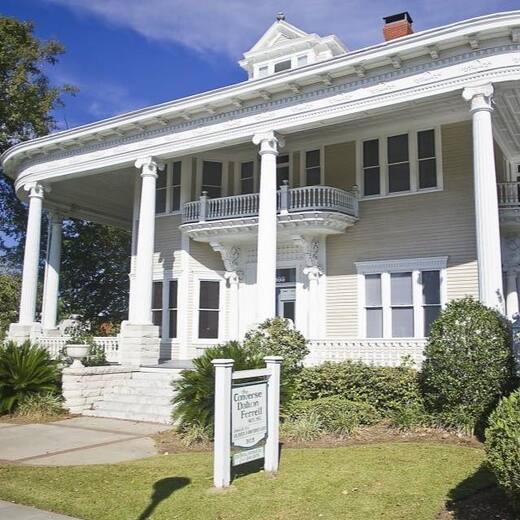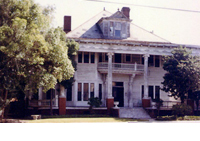The Historic Converse Dalton Ferrell House

The laurel wreath is a symbol of distinction, honor and achievement. Intricate wood carvings of the laurel wreath are seen throughout the interior and exterior of the Converse-Dalton-Ferrell House, home of the Valdosta Junior Service League. The house was restored to its original splendor by the League and placed on the National Historical Register in 1983. We are proud to honor this great landmark and to call it our home.
Events & Rentals
This beautifully restored historical home presents a memorable backdrop for parties, showers, small weddings Christmas and holiday parties, office parties and other special events.
For more information, email Jennifer Walker at VJSLRENTALS@GMAIL.COM or complete the form below.

EVENT AND RENTAL REQUEST FORM
HISTORY:
 The house was originally built in 1902 for Thomas Briggs Converse, Sr., his wife and their thirteen children. They lived in the home for sixteen years. Three of Converse's five daughters were married in the parlor. Later, after the Dalton family moved in in 1922, three more young ladies were married in the same room.
The house was originally built in 1902 for Thomas Briggs Converse, Sr., his wife and their thirteen children. They lived in the home for sixteen years. Three of Converse's five daughters were married in the parlor. Later, after the Dalton family moved in in 1922, three more young ladies were married in the same room.
Designed by Alex Everett, a local architect, the home was built by a Mr. Fulgum. Lumber for the house was cut from Converse's own farm, located in the countryside nearby. Woodwork and paneling for the house was custom made in Grand Rapids, Michigan, and features the laurel wreath designed mentioned above. The land surrounding the house originally extended further, and included a barn and stables in the back. A black iron fence originally enclosed the entire yard. Mrs. Converse would not plant many flowers or shrubbery because there were always children playing in the yard. Mrs. Susie McKey remembers some of the businessmen nearby would leave their stores in the afternoons and sit on the side porch to watch the boys play ball.
The front porch is a semi-circle with a large arc on the right porch to accentuate the bay windows on that side of the house. There are ten two-story high Ionic columns and two balconies. The white marble steps are twelve feet wide and have stoops on either side adorned by handsome Italian marble urns. The front door is flanked by two more Ionic columns and the side door to the dining room has a column under the balcony.
The front entrance opens to a small tiled vestibule with swinging doors. The front hall is twelve feet wide and has a chandelier with dozens of prisms. the three flights of stairs to the second floor are curved and have four-foot paneling and banisters which are carved and very intricate. The ceilings are twenty feet high, giving a distinct charm when entering the home. The woodwork and paneling throughout the house is four feet high except the living room, which has five foot high paneling. The double sliding paneled doors entering the living room, the parlor, and the dining room are fourteen feet high and framed with elaborate carved woodwork. The woodwork around the doors and windows features ledges and carvings, and all except the sliding doors have transoms over them. The finest metal fixtures and hardware was used on the doors, windows and drawers, and is still in good condition today. At the end of the front hall is a full length mirror to the ceiling with metal hooks on either side for coats. The children remember being reprimanded if they used the hooks facing the front hall instead of the ones facing the back hall as they were taught.
There are ten bedrooms and all rooms except two bedrooms had fireplaces. That includes a fireplace in the living room, parlor and dining room. The tile on the hearths and around the fireplaces is different in every room, and most is unmarred and looks as it did the day it was laid.
The living room has a beautiful semi-domed effect with six-sides and a recessed door to the porch. The mantle has a mantle over the mantle with the top mantle framing a mirror. There are columns on either side from the floor fifteen feet high to the top of the second mantle. Under the lower mantle, part of the carving are two lion heads with scroll and other carvings.
The dining room is especially impressive with nine deep inserts in the ceiling and carved oak beams accentuating the inserts. The large chandelier has six sides with six inner bulbs and six shades extended beyond the rim of the chandelier. This room and the bedroom above it have a bay window effect - a wall is built out and half-width windows are on either side. The recessed china cabinet has a mirrored back and drawers beneath the cabinet. The fireplace has tile of pale gold and the five-foot mantle has a ten-foot mantle over it. There is a column on either side on a hand carved oak base, the columns swirl gracefully and are reflected in the mirror on the ten-foot mantle.
Originally there were only three bathrooms, but now there are five. There are seven large bedrooms on the second floor, but only three have closets. The tile on all the fireplaces are beautifully colored -- one is lavender, another green, another blue, two are yellow and one is pale gold. The upstairs hall is twelve feet wide and sixty feet long. This hall leads to the "little" 12' x 15' porch at the back and to the balcony at the front of the house.
The bedroom over the dining room is 20' x 24', the closet is 3' x 10'. This room has the bay window effect like the dining room -- one wall built out for a window with half width windows on either side. The mantle is placed at an angle and built out from the wall. There is a hand-carved scroll beneath the ledge of the mantle and a pretty design carved in the ledge. This scroll and design is repeated on either side of the mantle over the mantle. The upper mantle is mirrored and has 4' cylinder shaped columns on either side of it.
The three flights of steps to the third floor lead to a romantic full sized ballroom (now used for League meetings). There are four alcoves -- one was for refreshments, one for the chaperones, one for the orchestra and one to rest or wait between dances. On hot summer nights the children of the families that lived in this home would sleep on the third floor. This way they could catch the occasional breeze. When their mother couldn't find the children one night, she rushed down to tell their father. Knowing that ten children could not just vanish, he searched and discovered all ten of the children sleeping on the roof. They had stepped out the door-size windows of the ballroom to enjoy the summer night under the stars.


